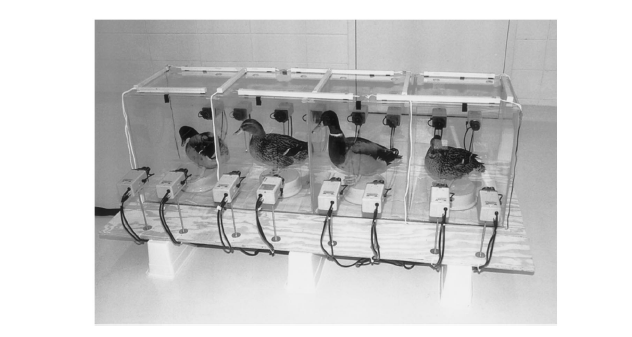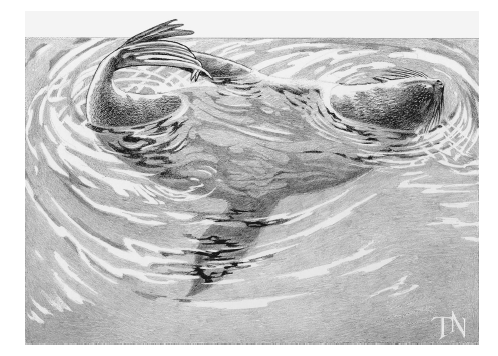Unihemispheric Slow-Wave Sleep
Amy Campbell and Daniel Denman ___________________________________Biology 342 Fall '06
Adaptive Value
If you do not sleep, you die. In most cases, this is due to a weakening and failure of the immune system (7, 9). Given this research, it is clear that sleep is a necessary part of any animal's behavior. But what are its benefits? It has been proposed that sleep has metabolic benefits and that it greatly aids (and may even be required for) memory consolidation. However, there are clear costs to sleeping; a bihemispherically sleeping animal is unable to monitor and interact with the environment around it. How does an animal balance the need for awareness of its surroundings with the clear necessity of sleep? Unihemispheric slow-wave sleep (USWS) appears to be one solution in which a cost-benefit balance between full bihemispheric sleep and the lack of any sleep is employed. The primary adaptive value of USWS is the ability to maintain vigilance while also sleeping; this manifests itself in various forms in a USWS-behaving animal's life history.
Anti-Predative
When compared to awake and alert animals, animals that are asleep are relatively unresponsive and unaware of their environment. This poses a clear danger in terms of predation. One might hypothesize that certain ways of sleeping are safer than others, and that animals might try to maximize the benefits of sleep (homeostasis, etc.) while reducing the costs (predation).
The most obvious hypothesis of the adaptive value of USWS concerns the increased ability of USWS-behaving animals to monitor their surroundings, especially possibilities of predation. The hypothesis that a USWS-behaving animal will preferrentially open the eye facing the direction of possible predator approach was directly tested by Rattenborg (22). In this experiment, the research team observed the sleeping behavior of mallard ducks (Anas platyrhynchos) in an experimental set-up in the laboratory. Using 8 video cameras to monitor spatially restricted ducks in a row, the team was able to monitor the eye opeing and closing of up to 4 ducks a night while simultaneously obtaining EEG recording from 2 of the the ducks (Figure 1).

Figure 1. Experimental chambers for monitoring USWS in mallards. From reference 22.
Utilizing this set-up, they showed that the mallards on the edges of the group showed a 150% increase in the amount of time in USWS; in addition, they showed that the ducks on the edges preferrentially directed their open eye away from the group. To further investigate a possible function of this behavior, the group ensured that the animals with open eyes directed away from the group were able to respond to a threatening stimulus. The conclusions drawn from this set of experiments point to an anti-predative value for USWS: a mallard can control which hlaf of its brain it will sleep with, allowing it to maintain a watch on approaching predators while partially gaining the benefits of sleep. This feature of USWS may be common to other USWS-behaving species as well: dolphins can also response to stimuli presented to the open eye during USWS.
Further support for this theory comes from laboratory experiments in which the brain activity and eye closure state of sleeping pigeons was recorded. It was noted that the pigeons preferentially opened the eye that faced out into the room instead of the one facing the wall of the testing and housing apparatus while utilizing USWS (24).
Early reports on mammalian sleep (1, 2) indicated that the predatory environment was roughly as important as brain mass and body size in determining sleep architecture. Mammals living in exposed environments had short sleep times and a low density of REM sleep. Predatory mammals were more likely to show large amounts of REM sleep. Not much is known about birds yet (13).
Maintaining Motor Function
Marine mammals face the peculiar challenge of periodically surfacing to breathe; the necessity to surface to breathe does not dissapear when the animal sleeps. To circumvent this problem, some marine mammals utilize USWS-behavior to maintain motor function of half of their body while sleeping. This allows them to remian afloat or resurface for air periodically. This behavior has been noted in fur-seals (see Figure 2) as well as bottlenose dolphins.

Figure 2. The posture of a unihemispherically slow-wave sleeping northern fur seal. In this drawing, the left hemisphere would be in USWS while the left side of the body paddles to keep the seal afloat. From reference 23.
It has been noted that the captive White-crowned sparrow (Zonotrichia leucophrys gambelii) sleeps remarkeably fewer hours (2/3 fewer) during the migratory season. Although, neither USWS or unilateral eye closure has been seen in this species, it has been hypothesized that they use USWS to maintain flight whilst sleeping. The migrating sparrows show no reduction in cognitive abilities while migrating, as measured by performance on a key pecking task; the authors hypothesize that in order to maintain this cognitive function concurrent with a dramatic reduction in bihemispheric sleep behavior, the sparrows could utilize a USWS strategy (25). To definitively show this, EEG recording from behaving, migrating sparrows would be required, a technologically difficult feat that has not yet been accomplished.
Social Monitoring
Dolphins often sleep in clusters. Pacific white-sided dolphins (Lagenorhynchus obliquidens) monitor each other with their open eye while sleeping in clusters. In a group of four captive dolphins, the individuals on the left of the sleeping cluster preferrentiallly open their right eye during USWS, while dolphins on the right of the sleeping cluster preferrentially open their left eye during USWS. In the figure below (Figure 3), dolphins 1 and 2 spend more time with the right eye open, while dolphins 3 and 4 spend more time with the left eye open. If a dolphin switched from one side of the group to the other, the dolphins preferrential eye state reversed (11, 26)

Figure 3. The organization of a sleeping cluster of Pacific white-sided dolphins. Numbers refer to dolphins. From reference 26.
The absolute adaptive value of this social monitoring is not obvious. Why would dolphins want to monitor each other, instead of keeping an eye out for predators like the ducks? Dolphins do maintain consistent family groups, and one hypothesis for the value of social monitoring is that they use it to maintain their physical proximity to each other while sleeping.
Memory Consolidation
It has recently been argued that the primary benefit of sleep is not metabolism, but memory consolidation. Additionally, it has been shown that SWS is the crucial part of sleep required for memory consolidation in humans (Nature Podcast, 09 November 2006). Memory consolidation during sleep extends to birds, as they refine their songs while sleeping (19).
Why is the sleep that animals who unihemispherically sleep display of the slow-wave variety? Why not REM? Perhaps the need for memory consolidation outweighs the need for maintained waking even under threat of predation and during the migratory season. USWS may facilitate a compromise between the need for memory consolidation and the need for maintained vigilance.